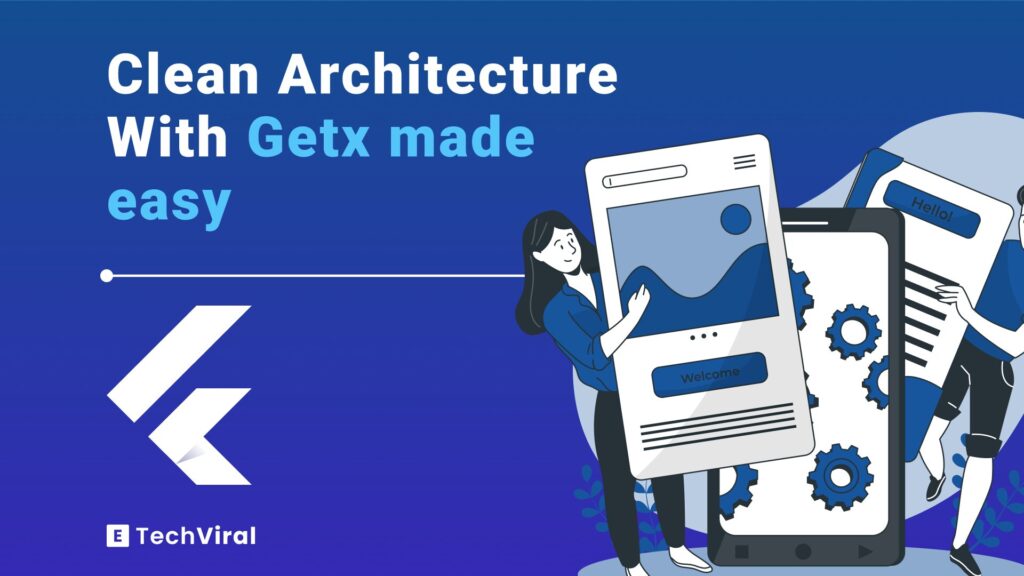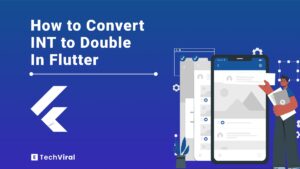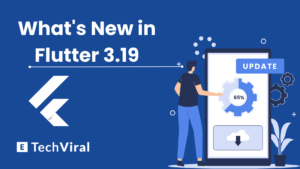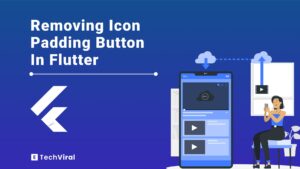Are you looking to elevate your Flutter projects with a robust and scalable architecture? Flutter Clean Architecture with Getx could be the game-changer, This powerful combination not only enhances code maintainability but also streamlines state management, making your development process smoother and more efficient.
Let’s dive into how integrating Getx with clean architecture in your Flutter applications can set you up for success.
Foundations of Clean Architecture in Flutter
There are two main types of architecture (Clean Architecture and MVVM) that experts developers using for building scalable and maintainable applications, but Clean Architecture, a concept popularized by Robert C. Martin (Uncle Bob), emphasizes the separation of concerns by dividing an application into distinct layers. In the context of Flutter, using clean architecture with riverpod also is a good choice for scalability of apps but applying Clean Architecture principles ensures that your codebase is scalable, maintainable, and easily testable. This approach is particularly beneficial for complex applications, allowing developers to manage code changes and feature additions seamlessly.
Understanding Clean Architecture Layers
- Entities: These are the core business objects of your application. In Flutter, entities represent the fundamental data structures that are independent of any UI or business logic. They are plain Dart classes that define the properties and functions of the data your application will work with.
- Use Cases (Interactors): Use cases encapsulate all the business rules and logic. They are where the application’s specific functionalities are implemented, acting as a bridge between the UI and the data. In Flutter, use cases manage the flow of data to and from the entities, ensuring that the business rules are adhered to.
- Repositories: Repositories abstract the data layer from the rest of the application. They provide a clean API for data access to the rest of the application. This layer is responsible for fetching data from various sources (like APIs, databases, etc.), abstracting the origin of the data from the use cases and entities.
- Controllers (Presenters in traditional Clean Architecture, adapted for Flutter with Getx): In the Flutter Clean Architecture and Getx setup, controllers replace presenters. They are responsible for reacting to user inputs, fetching data via use cases, and updating the UI. With Getx, controllers are also used for state management, making it easier to manage the application’s state reactively.
The Importance of Separation of Concerns
Separation of concerns is a design principle for separating a computer program into distinct sections, where each section addresses a separate concern. Applying this principle through clean architecture in Flutter applications, ensures that modifications in one part of the system have minimal impact on others. This modularity facilitates easier testing, maintenance, and scaling of the application.
Why Getx for Clean Architecture in Flutter?
Getx is a highly efficient, lightweight, and powerful solution for managing state, navigation, and dependencies in Flutter applications. Its compatibility with Clean Architecture principles makes it an ideal choice for developers looking to build scalable and maintainable Flutter applications. Here’s why Getx stands out as the perfect partner for implementing Clean Architecture in your Flutter projects:
Effortless State Management
Getx simplifies state management with reactive programming. It allows developers to easily track and respond to changes in the application’s state, ensuring that the UI is always in sync with the underlying data models. This reactive approach fits seamlessly within the Clean Architecture framework, where the Controller (or Presenter) layer is responsible for updating the UI based on business logic and user interactions.
Simplified Navigation and Route Management
Navigation can often become cumbersome in large Flutter applications. Getx offers a straightforward and powerful way to manage routes, including dynamic URL parameters, middleware, and nested navigation. This simplifies implementing Clean Architecture, where the separation of concerns extends to navigating between different parts of the application.
Dependency Injection Made Easy
Dependency injection is a core aspect of Clean Architecture, promoting modularity and testability. Getx provides a straightforward method for dependency management, allowing you to easily decouple your classes and increase the testability of your application. With Getx, dependencies can be lazily loaded, ensuring that your app remains efficient and performant.
Enhanced Productivity and Maintainability
By leveraging Getx for Clean Architecture in Flutter applications, developers benefit from reduced boilerplate code, increased development speed, and improved application performance. Getx’s approach to state management, navigation, and dependency injection aligns with the goals of Clean Architecture, making the codebase more maintainable and easier to scale.
Integration with Flutter’s Ecosystem
Getx is designed to work harmoniously within Flutter’s ecosystem, complementing its features and capabilities. This integration ensures that developers can adopt Clean Architecture principles without sacrificing the benefits of Flutter, such as hot reload and a rich set of UI components.
Project Setup and Structure
Initiating a Flutter project with Clean Architecture and Getx requires careful planning and organization. This setup ensures that your project is scalable, maintainable, and adheres to Clean Architecture principles from the start. Here’s how to structure your Flutter project using Getx for optimal organization and efficiency.
Initial Setup
1. Create a New Flutter Project:
Begin by creating a new Flutter project in your IDE of choice. This serves as the foundation for implementing Clean Architecture and Getx.
2. Add Getx to Your Project:
Incorporate Getx into your project by adding it to your pubspec.yaml file. Getx will manage state, dependencies, and navigation in your app.
dependencies:
flutter:
sdk: flutter
get: ^latest_version
3. Directory Structure:
Organize your project into directories that reflect the Clean Architecture layers. A recommended structure might look like this:
/lib
/data
/datasources
/models
/repositories
/domain
/entities
/repositories
/usecases
/presentation
/controllers
/pages
/widgets
/core
/routes
/utils
This structure separates your project into clear layers, each with a specific responsibility:
- Data Layer (/data): Handles data manipulation and communication with external sources (APIs, databases).
- Domain Layer (/domain): Contains the core business logic, including entities and use cases.
- Presentation Layer (/presentation): Manages everything related to the UI, including screens (/pages), widgets, and state management (/controllers with Getx).
- Core (/core): Includes application-wide utilities like routing configurations and helper functions.
Configuring Getx
- State Management:
Use GetX, Obx, and GetBuilder widgets for reactive state management. Define your controllers in the /presentation/controllers directory to manage the state of your UI components.
- Navigation and Routes:
Set up named routes in the /core/routes directory. With Getx, you can manage routes and navigate between pages without the need for a BuildContext.
- Dependency Injection:
Utilize Getx’s powerful dependency injection features to manage your app’s dependencies. Define them in a central location, such as the /core/utils directory, for easy access and management.
Detailed Implementation Guide
With your Flutter project structured and Getx integrated, it’s time to dive into the implementation details of Clean Architecture within this framework. This guide will walk you through setting up each layer, focusing on how Getx facilitates clean, maintainable code.
Entities Layer
- Defining Entities:
- Entities are the core business models of your application. In the /domain/entities directory, define Dart classes that represent these models. For instance, if you’re building a task management app, you might have a Task entity.
- Ensure these entities are plain objects, devoid of any business logic or dependencies on other layers.
Use Cases Layer
- Implementing Use Cases:
- Use cases encapsulate the business logic of your application. They reside in the /domain/usecases directory.
- Each use case should perform a single task, such as fetching tasks from a repository. Use Getx to manage dependencies and inject repositories needed by your use cases.
Repositories Layer
- Setting Up Repositories:
- In clean architecture repositories abstract the source of data for your app, whether it’s from a local database or a remote server. Define interfaces in the /domain/repositories directory and implementations in the /data/repositories directory.
- Use Getx for dependency injection, ensuring that your use cases can access these repositories without being aware of their concrete implementations.
- Data Sources:
- Organize data sources into local and remote sources within the /data/datasources directory. These sources handle the actual data retrieval and storage operations.
- Employ Getx for managing API clients and database connections, making it easy to switch between different data sources as needed.
Controllers Layer with Getx
- Creating Controllers:
- Controllers act as the bridge between your UI (presentation layer) and the business logic (use cases). They reside in the /presentation/controllers directory.
- Leverage Getx controllers (GetXController) to observe changes in the data layer and update the UI reactively. Bind your controllers to UI elements using Obx() or GetX() widgets.
- State Management:
- Utilize Getx’s reactive state management features to update your UI based on user interactions or data changes. Define reactive variables in your controllers and update them within your use cases.
- This reactive pattern ensures that your UI always reflects the current state of the application, enhancing user experience.
Routing and Navigation with Getx
- Configuring Routes:
- Define named routes in the /core/routes directory, specifying the mapping between route names and pages.
- Getx simplifies navigation by allowing you to navigate between pages using route names, without the need for BuildContext.
- Navigating Between Screens:
- Use Getx’s navigation methods (Get.to(), Get.off(), etc.) to move between screens. Pass data between routes easily with Getx, enhancing the modularity and flexibility of your application.
Flutter Clean Architecture With Getx Sample Application
To solidify your understanding of Flutter Clean Architecture with Getx, let’s walk through creating a simple application—a task management app. This example will demonstrate the practical application of the concepts discussed, showing how to structure your app, implement functionality, and manage state with Getx.
Overview of the Sample App
Our task management app will allow users to create, view, update, and delete tasks. It will have a minimal UI with screens for listing tasks, viewing task details, and adding or editing tasks. This example will focus on the Clean Architecture setup and the integration of Getx for state management and navigation.
Step 1: Setting Up the Project Structure
Ensure your project is organized according to the structure outlined in Section 3. This structure supports Clean Architecture principles and facilitates the use of Getx for various functionalities.
Step 2: Defining Entities
In the /domain/entities directory, define a Task entity:
class Task {
final int id;
final String title;
final String description;
Task({required this.id, required this.title, required this.description});
}
Step 3: Implementing Use Cases
Create use cases for interacting with tasks in the /domain/usecases directory. For simplicity, let’s define a use case for fetching all tasks:
class GetTasksUseCase {
final TaskRepository repository;
GetTasksUseCase(this.repository);
Future<List<Task>> call() async {
return await repository.getTasks();
}
}
Step 4: Setting Up Repositories and Data Sources
Define a TaskRepository interface in /domain/repositories and its implementation in /data/repositories. Use a mock data source in /data/datasources for this example:
// In domain/repositories/task_repository.dart
abstract class TaskRepository {
Future<List<Task>> getTasks();
}
// In data/repositories/task_repository_impl.dart
class TaskRepositoryImpl implements TaskRepository {
final TaskDataSource dataSource;
TaskRepositoryImpl(this.dataSource);
@override
Future<List<Task>> getTasks() => dataSource.getTasks();
}
// In data/datasources/task_data_source.dart
class TaskDataSource {
Future<List<Task>> getTasks() async {
// Return a list of mock tasks
}
}
Step 5: Creating Controllers with Getx
Develop a TaskController in /presentation/controllers using Getx to manage the state of tasks:
class TaskController extends GetxController {
final GetTasksUseCase getTasksUseCase;
var tasks = <Task>[].obs;
TaskController(this.getTasksUseCase);
@override
void onInit() {
super.onInit();
fetchTasks();
}
void fetchTasks() async {
final result = await getTasksUseCase();
tasks.assignAll(result);
}
}
Step 6: Designing the UI and Integrating Controllers
Create screens in /presentation/pages for listing, viewing, and editing tasks. Use Obx() to reactively update the UI based on the controller’s state. For navigation, use Getx’s routing capabilities to move between these screens.
Step 7: Adding Navigation with Getx
Configure named routes in /core/routes and use Getx’s navigation methods (Get.toNamed(), Get.back(), etc.) to navigate between screens without direct dependency on the navigation context.
This sample application showcases how to apply Clean Architecture principles in a Flutter project with Getx, from structuring your app to implementing functionality and managing state.
Testing and Quality Assurance
Testing is a critical component of developing reliable and maintainable applications. Flutter, combined with Clean Architecture and Getx, offers a structured approach to writing tests that cover unit, widget, and integration tests. This section will guide you through testing strategies for your Clean Architecture app with Getx, ensuring each layer of your application is thoroughly tested.
Unit Testing Entities and Use Cases
- 1. Entities:
- Entities are simple data models and typically don’t contain business logic. However, you should still write tests to ensure their integrity, especially if they include custom getters or methods.
test('Task entity test', () {
final task = Task(id: 1, title: 'Test Task', description: 'Test Description');
expect(task.id, 1);
expect(task.title, 'Test Task');
expect(task.description, 'Test Description');
});
2. Use Cases:
- Use cases encapsulate business logic. Mock dependencies like repositories to test use cases in isolation.
- Use the mockito package for mocking dependencies in Flutter.
class MockTaskRepository extends Mock implements TaskRepository {}
void main() {
late GetTasksUseCase getTasksUseCase;
late MockTaskRepository mockTaskRepository;
setUp(() {
mockTaskRepository = MockTaskRepository();
getTasksUseCase = GetTasksUseCase(mockTaskRepository);
});
test('should get tasks from the repository', () async {
// Arrange
when(mockTaskRepository.getTasks()).thenAnswer((_) async => [Task(...)]);
// Act
final result = await getTasksUseCase.call();
// Assert
expect(result, isA<List<Task>>());
verify(mockTaskRepository.getTasks());
verifyNoMoreInteractions(mockTaskRepository);
});
}
Testing Repositories
- Repositories:
- Repositories interact with data sources. Mock data sources to test repository logic.
- Ensure repositories correctly handle data transformation and error handling.
Testing Controllers with Getx
- 1. Controllers:
- Controllers manage state and interact with use cases. Test controllers by mocking use cases and observing state changes.
- Use Getx’s TestWidgetsFlutterBinding.ensureInitialized() for initializing the testing environment.
void main() {
late TaskController taskController;
late GetTasksUseCase mockGetTasksUseCase;
setUp(() {
TestWidgetsFlutterBinding.ensureInitialized();
mockGetTasksUseCase = MockGetTasksUseCase();
taskController = TaskController(mockGetTasksUseCase);
});
test('fetchTasks updates tasks list', () async {
// Arrange
when(mockGetTasksUseCase.call()).thenAnswer((_) async => [Task(...)]);
// Act
taskController.fetchTasks();
// Assert
expect(taskController.tasks.length, 1);
});
}
Integration Testing
- 1. Full App Testing:
- Integration tests evaluate the app as a whole, ensuring that all components work together as expected.
- Use the flutter_test package along with flutter_driver for driving the app and performing tests.
group('App Integration Tests', () {
testWidgets('Complete Task Flow', (WidgetTester tester) async {
// Initialize the app
await tester.pumpWidget(MyApp());
// Navigate, interact, and verify app behavior
});
});
Best Practices and Optimization of Flutter Getx
Adopting Flutter Clean Architect with Getx is a strategic move towards building scalable, maintainable, and testable applications. However, to fully leverage its benefits, it’s crucial to follow best practices and optimization strategies. This section outlines key considerations to maximize the effectiveness of your Clean Architecture and Getx implementation.
Embrace Modularization
- Divide and Conquer: Break down your application into modules or packages based on features or functionality. This approach enhances readability, simplifies testing, and facilitates team collaboration.
- Feature-based Structuring: Organize your directories and files around features rather than layer types. This keeps related code together, making it easier to navigate and understand the codebase.
Efficient State Management
- Reactive State Management: Utilize Getx’s reactive features (Rx<Type>, Obx, etc.) judiciously. Overuse can lead to unnecessary complexity. Aim for a balance between reactive and traditional state management based on your app’s needs.
- Stateless Widgets: Whenever possible, use stateless widgets to reduce overhead and improve your app’s performance. Reserve stateful widgets for cases where they are genuinely needed.
Optimize Dependencies
- Lazy Loading: Take advantage of Getx’s lazy loading for dependencies. This ensures that objects are only created when they are needed, reducing initial load times and conserving resources.
- Singleton Services: For services that maintain state or cache data, consider implementing them as singletons. This can be easily managed with Getx’s dependency injection system.
Navigation and Routing
- Named Routes: Utilize Getx’s support for named routes to simplify navigation logic. Named routes make your navigation calls more descriptive and easier to manage.
- Middleware: Use Getx’s middleware capabilities to manage route guards, logging, or to inject dependencies before a route is followed. This can be particularly useful for features like authentication checks.
Testing and Quality Assurance
- Comprehensive Testing: Cover all layers of your application with unit, widget, and integration tests. Pay special attention to testing business logic in use cases and the integration between controllers and UI components.
- Mocking and Faking: Use mocking frameworks like Mockito for your tests. Mock dependencies in unit tests to isolate and test specific pieces of logic.
Continuous Learning and Adaptation
- Stay Updated: Getx and Flutter are actively developed and frequently updated. Keep abreast of the latest changes and improvements to ensure you’re using the most efficient methods and features.
- Community Engagement: Participate in the Flutter and Getx communities. Sharing experiences, challenges, and solutions with others can provide new insights and approaches to common problems.
Performance Considerations
- Profile Your App: Regularly use Flutter’s profiling tools to identify and address performance bottlenecks. Pay attention to CPU and memory usage to ensure your app runs smoothly across all target devices.
- Use Widgets Sparingly: Widgets are the building blocks of your UI, but overuse can lead to performance issues. Be mindful of the widget tree depth and complexity.
Conclusion
mastering Flutter Clean Architecture with Getx offers a pathway to building scalable, maintainable, and efficient applications. By adhering to the principles of Clean Architecture and leveraging the powerful features of Getx, developers can enhance the quality of their Flutter projects, ensuring they are well-structured and easy to manage.
This guide has walked you through the foundational concepts, practical implementation, and testing strategies to get you started. As you continue to explore and apply these practices, remember that the Flutter and Getx communities are vibrant and supportive resources for further learning and growth. Embrace the journey of continuous improvement, and let Clean Architecture and Getx elevate your Flutter development to new heights.
Frequently Ask Question
How does Clean Architecture benefit Flutter development?
Implementing Clean Architecture in Flutter projects promotes a clear separation of concerns, making the codebase more manageable, scalable, and testable. It enhances development efficiency and application performance by organizing code into modular, interchangeable layers.
Can I use Getx for large-scale applications?
Absolutely. Getx is designed to efficiently manage state, dependencies, and routing in Flutter applications of any scale. Its performance optimizations and scalability make it suitable for both small and large-scale projects.
How do I start implementing Clean Architecture and Getx in my existing Flutter project?
Start by refactoring your project’s structure to align with Clean Architecture layers: Presentation, Domain, and Data. Gradually integrate Getx for state management, routing, and dependency injection, layer by layer, ensuring each part of your app adheres to Clean Architecture principles.
Are there any performance concerns when using Clean Architecture with Getx in Flutter?
When implemented correctly, Clean Architecture and Getx should enhance your app’s performance and maintainability. However, be mindful of overusing reactive states or unnecessary dependencies, as these can impact performance. Profiling and optimization should be ongoing processes in your development cycle.
Where can I find more resources on Flutter Clean Architecture and Getx?
Refer to the official Flutter and Getx documentation for foundational knowledge. Online platforms like Udemy, Coursera, and YouTube offer comprehensive tutorials. Additionally, community forums like Stack Overflow, Reddit, and Flutter community channels on Discord or Slack are invaluable resources.
How do I handle complex state management scenarios with Getx?
Getx supports a variety of state management approaches, from simple Obx() widgets for reactive updates to more complex scenarios using GetXController. For intricate state management needs, consider combining Getx with other patterns or techniques, such as Provider or BLoC, tailored to your project’s requirements.











